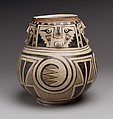Jar with Four Faces
Not on view
Between the mid-thirteenth and mid-fifteenth centuries, the arid region that stretches from northern Mexico to the southwestern United States was dominated by the powerful city of Casas Grandes. Located in what is now the Mexican state of Chihuahua, Casas Grandes was a well planned urban center made wealthy by trade in precious commodities such as shell, copper, turquoise, and tropical bird feathers. The city's craftsmen, skilled in the working of such materials, increased its wealth by making finished products for export. Among those finished products were ceramic vessels with bright polychrome surfaces. The vessels, principally globular jars, were much esteemed and widely traded. In their manufacture, certain more-or-less standardized systems of shape and decoration were followed that included restrained color schemes—chiefly blue/blacks and brown/reds—geometric patterns, and a particularized use of human and animal imagery. Janus-faced jars are among the vessels, some with the same face on each side, others with different faces. The present example has carried the multiple aspect one step further by incorporating the same face four times onto the top circumference of the jar.
This image cannot be enlarged, viewed at full screen, or downloaded.

